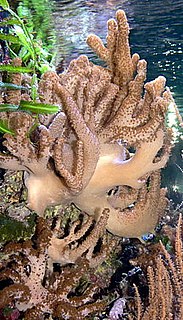
Alcyonacea, or soft corals, are an order of corals. In addition to the fleshy soft corals, the order Alcyonacea now contains all species previously known as "gorgonian corals", that produce a more or less hard skeleton, though quite different from "true" corals (Scleractinia). These can be found in suborders Holaxonia, Scleraxonia, and Stolonifera. They are sessile colonial cnidarians that are found throughout the oceans of the world, especially in the deep sea, polar waters, tropics and subtropics. Common names for subsets of this order are sea fans and sea whips; others are similar to the sea pens of related order Pennatulacea. Individual tiny polyps form colonies that are normally erect, flattened, branching, and reminiscent of a fan. Others may be whiplike, bushy, or even encrusting. A colony can be several feet high and across, but only a few inches thick. They may be brightly coloured, often purple, red, or yellow. Photosynthetic gorgonians can be successfully kept in captive aquaria.
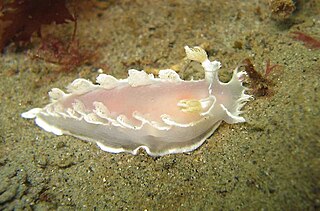
The Tritoniidae are a taxonomic family of dendronotid nudibranchs, shell-less marine gastropod molluscs. This family includes some of the largest known nudibranchs, with the NE Atlantic species Tritonia hombergii reaching 20 cm in length.

The diamondback tritonia is a species of nudibranch, a marine gastropod mollusk in the family Tritoniidae. It is an opportunistic predator of other marine invertebrates.

Tritonia is a genus of sea slugs, nudibranchs, shell-less marine gastropod molluscs in the family Tritoniidae.
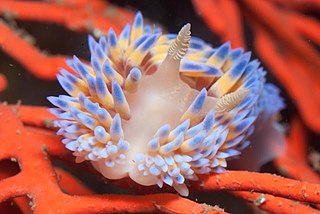
The gasflame nudibranch is a very colourful species of nudibranch, or sea slug. It is a marine gastropod mollusc in the family Proctonotidae. Bonisa nakaza is the only species in the genus Bonisa.

The soft coral nudibranch, Tritonia sp. 1, as designated by Gosliner, 1987, is a species of small sea slug, a dendronotid nudibranch. It is a marine gastropod mollusc in the family Tritoniidae. As of November 2009, it was undescribed by science.

The brush nudibranch, Tritonia sp. 2, as designated by Gosliner, 1987, is a species of dendronotid nudibranch. It is a marine gastropod mollusc in the family Tritoniidae. As at November 2009, it remained undescribed by science.
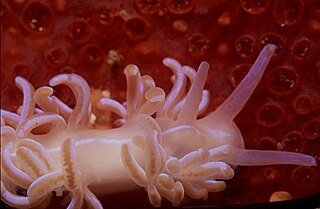
Phyllodesmium horridum, the coral nudibranch, is a species of sea slug, specifically an aeolid nudibranch. It is a marine gastropod mollusc in the family Facelinidae.

Tritonicula bayeri is a species of dendronotid nudibranch. It is a marine gastropod mollusc in the family Tritoniidae. A number of Caribbean and western Pacific species of Tritonia were moved to a new genus Tritonicula in 2020 as a result of an integrative taxonomic study of the family Tritoniidae.

Tritonicula hamnerorum is a species of dendronotid nudibranch. It is a marine gastropod mollusc in the family Tritoniidae. A number of Caribbean species of Tritonia were moved to a new genus Tritonicula in 2020 as a result of an integrative taxonomic study of the family Tritoniidae.

Duvaucelia lineata is a species of dendronotid nudibranch. It is a marine gastropod mollusc in the family Tritoniidae. Previously known as Tritonia lineata this species was moved to the genus Duvaucelia in 2020.
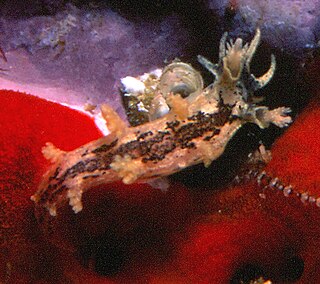
Duvaucelia manicata is a species of dendronotid nudibranch. It is a marine gastropod mollusc in the family Tritoniidae.

Leptogorgia virgulata, commonly known as the sea whip or colorful sea whip, is a species of soft coral in the family Gorgoniidae.
Tritonicula wellsi, the sea whip slug, is a species of nudibranch, a shell-less marine gastropod mollusc in the family Tritoniidae. The type locality is Beaufort, North Carolina. A number of Caribbean and western Pacific species of Tritonia were moved to a new genus Tritonicula in 2020 as a result of an integrative taxonomic study of the family Tritoniidae.

The whip fan, also called the flagellar sea fan, is a species of gorgonian sea fan in the family Gorgoniidae.
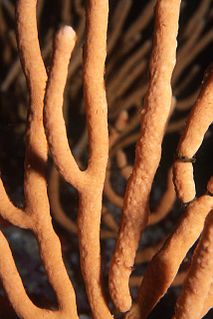
The nippled sea fan, is a species of gorgonian sea fan in the family Gorgoniidae.

The sinuous sea fan is a species of gorgonian sea fan in the family Gorgoniidae.

Eunicella singularis, the white gorgonian, is a species of colonial soft coral, a sea fan in the family Gorgoniidae. It is found in the western Mediterranean Sea, Adriatic Sea and Ionian Sea. It was first described in 1791 by the German naturalist Eugenius Johann Christoph Esper.
Duvaucelia is a genus of sea slugs, nudibranchs, shell-less marine gastropod molluscs in the family Tritoniidae. It was synonymised with Tritonia until 2020 when a revision of the family Tritoniidae brought it back into use.

















